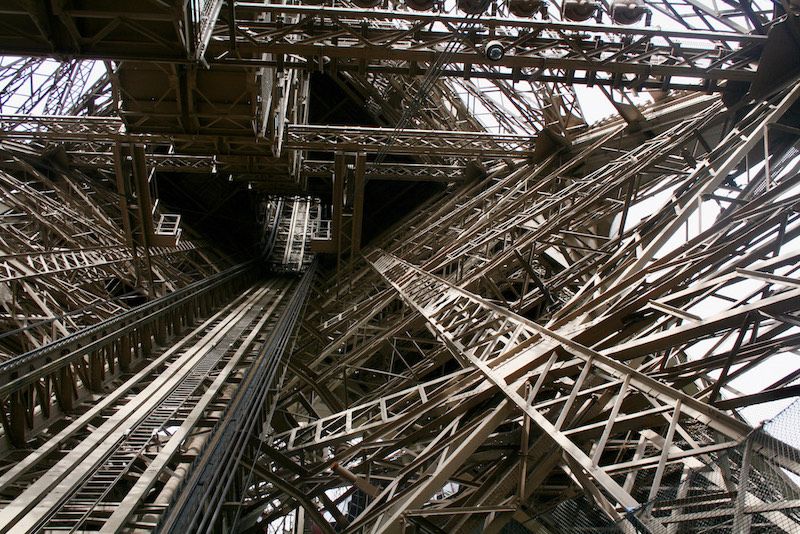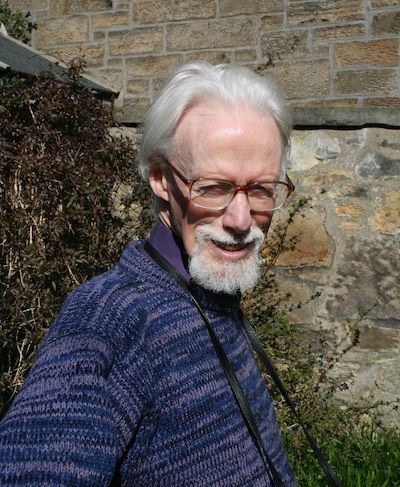Le Fer by Joris-Karl Huysmans: Against The Eiffel Tower

From Inside the Beast : The Eiffel Tower by Lewis Martin
Introduction
The following post is by my Father Graham Dunstan Martin. He sent this to me after a conversation we had over the phone a few years ago. I don’t remember exactly what we started talking about but we ended up with dad telling me about this passage by a famous French author Joris-Karl Huysmans about the Eiffel Tower which had been newly erected in his beloved Paris and had enraged him.
I really wanted to know what he said, it seems so many of the worlds great landmarks start off life being despised. I wanted to know exactly what he objected to.
It’s well known anecdotally that Parisians always have loved to hate the tower. Strong opposition at the time is also well documented. A short trip to the wikipedia page of the Eiffel Tower will show you that with people like Charles Garnier, William-Adolphe Bouguereau, Guy de Maupassant, Charles Gounod and Jules Massenet organising against it.
 Graham Dunstan Martin
Graham Dunstan Martin
But also this famous writer Joris-Karl Huysmans that dad remembered wrote an essay against it. The essay was called Le Fer and dad being a retired French lecturer of course helps a little when you want to translate some French.
Dad passed away recently and I wanted to put this back up on the internet for him. So please see below as far as I know the only public translation of Le Fer by Joris-Karl-Karl Huysmans first published in 1889 with some commentary by Graham Dunstan Martin.
…
Le Fer by Joris-Karl Huysmans with Commentary by Graham Dunstan Martin
Joris-Karl Huysmans(1848-1907) is an important French novelist, author of A Rebours (Against Nature / In Reverse)and Là-Bas (Down There). His little book Certains (Tresse & Stock 1889) is a set of essays in consciously beautiful French, among which we can find (in an article entitled Le Fer (Iron)) a quite savage attack on the Eiffel Tower, which had just been erected for the Paris Exposition of that year. It is perhaps interesting to read, as revealing common attitudes of the time - though not the only one by any means, since we shall see Huysmans himself deploring the contemporary view that the Tower is a wonder, and must not be dismantled.
My memory tells me that it was precisely by popular acclaim that it was allowed to remain standing. His objections to the Tower are several:
- It’s a monument to Capitalism (which, as an artist, he detests)
- It’s ugly
- It lacks decoration
- It looks unfinished;
- It’s not outlandish or imaginative enough (he wants a touch of the diabolic!)
- It’s not big enough;
- It looks like practical structures like bridges.
Capitalism, he sarcastically declares, is the new religion, the monstrous source of this modern architecture. It is;
a church consecrated to the cult of gold, sanctified by an altar which is climbed, to the sound of steam organs, by the richest man in the world, the American Pope, Jay Gould, who celebrates the yellow Mass, and who before the kneeling crowd, to the repeated summons of electric bells, elevates the Host, that is to say the Cheque, torn from a counterfoil-book.
Yellow was a colour much celebrated at this period by the artistic movement of the decadents. The ‘yellow Mass’ suggests sickness, jaundice, but also gold.
In front of this temple there rises the famous Tower about which the whole universe is raving. Every kind of dithyramb has raged. The Tower has not (as people feared) brought thunderbolts down upon itself, but the same old dreadful refrain: ‘triumphal arch of industry, tower of Babel, Vulcan, Cyclops, spider’s web of metal, lacework of iron.’ With a touching unanimity no doubt taken for granted, the entire printed press, flat on its face, has proclaimed the genius of M. Eiffel. And yet his tower looks like a half-built factory chimney, a carcass waiting to be filled by freestone or bricks.
You can’t imagine that this funnel-shaped piece of wire-netting could be complete, that this lonely suppository full of perforations is going to stay like that. This resemblance to scaffolding, this state of incompletion assigned to a building that is now complete, reveal an absolute artistic nonsense. The Eiffel Tower is truly of a disconcerting ugliness, and it isn’t even enormous! Seen from below, it doesn’t seem to reach the height that they claim for it. […] Seen from afar, it’s still worse.This shaft hardly overtops the summit of named monuments. From the Esplanade of the Invalides, for instance, it is hardly twice the height of a five-storey house.…..
I’ve cut a little here.
In short, whether drawn or engraved, it is mean and trivial. And what is this wicker flask of painted straw, capped by its campanile as by a cork decorated with a drop-measure, beside the powerful structures dreamed of by Piranesi, or even the monuments invented by the Englishman Martins? ((Until quite recently the French have been extraordinarily careless when spelling English words and names. Perhaps Huysmans presumes that Martin must have an S at the end of his name because he, Huysmans, has one at the end of his. I presume this is John Martin (1789-1854), author of gloomy, fantastic and apocalyptic paintings.No relation, I believe.))
From whatever angle one looks, this work tells lies. It is three hundred metres high and appears to be one hundred; it is finished, and appears to be hardly begun.
So much for the honesty of building a skeleton of iron and showing the structure of that building. So much for revealing the skeleton in a building (as nature has not, in the case of human bodies).
In the absence of a form of art which would perhaps be difficult to invent, with these trellises which are really no more than piled-up masses of bridges, you’d have had to fabricate something gigantic, inspire us with the feeling of the enormous; this tower should have been monstrous, should have shot up to crazy heights, should have torn space apart, should have planted its dome more than two thousand metres high, like a unprecedented milestone in the astonished highway of the clouds!
Here Huysmans shows his taste (not only for his own gift of words, of course!) but also for the ‘decadent art’ of his own day: his taste for the astonishing, the outrageous, the sinister, the excessive, the unnatural. And surely he’s asking too much of the technology of his day? As he immediately then admits:
It was unachievable; so what was the point of setting up this empty obelisk on its hollow plinth? No doubt it’ll seduce flashy foreigners, ((The insulting term rastaqouères is used here.)) but it won’t disappear with them, along with the galleries of the Exposition, like the blue cupolas whose partitioned bling ((Please excuse my use of this 1990s term in the translation!)) will be sold off by the pound.
If now we turn from the general ensemble to the detail, one remains astonished by the crudity of each element.
The modern blacksmith (he goes on to say) has been capable of forging human and animal figures, flowers, etc. But there’s no such thing in the Eiffel Tower:
Here there is nothing: no decoration however timid, no caprice, no vestige of art. When you penetrate into the tower, you find yourself facing a chaos of beams, interlocked, riveted together by bolts, hammered in by nails. You can only think of struts preventing the collapse of an invisible building. You can only shrug your shoulders before this splendour of wire and plate, before this apotheosis of the viaduct pier, of the superstructure of bridges.
NB ‘if it’s without decoration it isn’t art’. More recently there has of course been an opposing point of view — that decoration is a sure sign of an outdated past. Mind you, is decoration ‘decoration’ or is it something more interesting? In the same way as in literature, but most particularly in poetry, simile and metaphor aren’t ‘decoration’ but the very heart of the matter — and yet there used to be a critical school of thought which had never grasped that fact and which continued to define metaphor as ‘mere decoration’ - so decoration in architecture is surely not a mere futile superfluity.
In fact we should ask ourselves what is the raison d’être of this tower. If you look at it alone, isolated from other buildings, separated from the palace by which it stands, it offers no meaning, it is absurd. If on the other hand you look at it as forming part of a whole, as belonging to the ensemble of structures erected on the Champ de Mars, you can conjecture that it is the steeple of the New Church which celebrates (as I said above) the divine service of the Sublime Bank. It would then become the belfry, separated, as at Utrecht Cathedral, by a vast square from the transept and the choir.
Huysmans’s hostility to the Tower is (at least in part) because he attributes its style, its method of construction, its very existence to the power of the Great God Money in the modern world — a power which he evidently deprecates. For what reason? Among others no doubt, here is the hostility of the artist for the philistine, a hostility widespread also in the Britain of that time.
In this case, its strong-box material, its beef-stew colour, its factory-pipe structure, its oil-well form, its skeleton like a huge dredger designed for extracting gold-bearing silts from the Stock Markets, would be explained. It would be the spire of Our Lady of Second-Hand Trading, a spire deprived of bells but armed with a cannon which announces the opening and the end of the working day, which calls the faithful to the Masses of high finance, to the Vespers of the bank charge, a cannon which rings out in volleys of gunpowder the liturgical festivals of Capital!
It would be, like the gallery of the monumental dome which it completes, the emblem of an epoch dominated by the passion of profit; but, oblivious to that, the architect who built it has failed to discover the ferocious but cunning style, the diabolic character which this allegory demands. Truly this pylon built of grills would make you hate the metal which allows itself to be confectioned into such works, were it not for the fact that, inside the stupendous nave of the palace of machines, the incomparable power of metal bursts forth.
Huysmans then seems to turn to another building, which he calls ‘the nave of the palace of machines’, and we need to quote only his final paragraph:
Architecture has therefore not made a new step in this direction. For the lack of a man of genius, iron is as yet incapable of creating a complete personal work, a true masterpiece.
Here is the word oeuvre, work, used in its sense of the summit of achievement, or masterpiece. Poor old Eiffel!
Are you persuaded? Words are for persuading, of course, and Huysmans was a master of them, choosing above all those things which he could either love or hate, which gave him an opportunity to enjoy his own command of French, whether vitriolic or lyrical. And yet the argument has passed on very far since his days. But then again, I thought it might be interesting to look at this aspect of the timeless argument: What should one build? And why? And how should one build it?
-© Graham Dunstan Martin
- Location 48°51’29.6”N 2°17’40.2”E